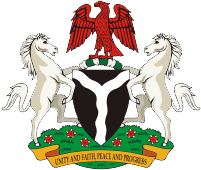Military of Nigeria
From Roach Busters

| |
| Current form | 1960 |
| Service branches | Army, Navy, Air Force |
| Headquarters | Lagos |
| Commander-in-Chief | Pres. Mohammed Abubakar |
| Minister of National Defense | Gen. Adekunle Bakare |
| Military age | 18 years of age |
| Available for military service | males age 16-49: 31,929,204 females age 16-49: 30,638,979 |
| Fit for military service | males age 16-49: 18,556,755 females age 16-49: 17,288,225 |
| Availability | males age 15-49: 146,651,066 (2005 est.) |
| Reaching military age annually | males age 16-49: 1,533,974 females age 16-49: 1,509,619 |
| Active personnel | 287,000 |
| Reserve personnel | 355,000 |
| Percent of GDP | 6% (2006 est.) |
The Nigerian Armed Forces has active duty personnel in three armed services, totalling approximately 287,000 troops and 82,000 paramilitary personnel. Its origins lie in the elements of the Royal West African Frontier Force that became Nigerian when independence was granted in 1960. In 1956 the Nigeria Regiment of the RWAFF was renamed the Nigerian Military Forces, RWAFF, and in April 1958 the colonial government of Nigeria took over from the British War Office control of the Nigerian Military Forces.
Since its creation the Nigerian military has sent peacekeeping forces abroad both with the United Nations and as the backbone of the ECOWAS-sponsored ECOWAS Cease-fire Monitoring Group (ECOMOG) in Liberia and Sierra Leone. It also seized power in the mid-1960s, and remains firmly in control of the nation to this day, making Nigeria one of Africa's longest-lived military dictatorships. The military has become entrenched in all facets of Nigerian civic and economic life.
